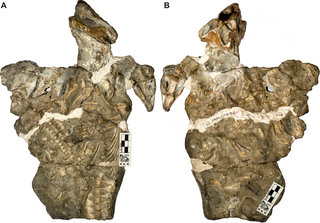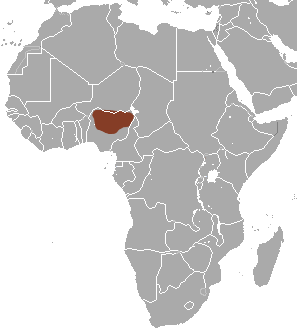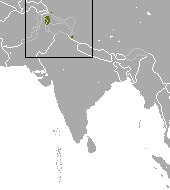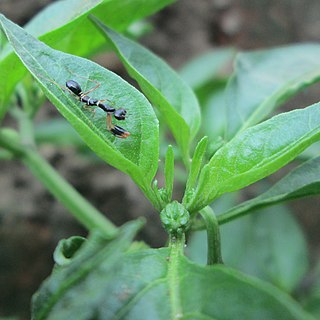
The flat-headed cat is a small wild cat with short reddish-brown fur. Its head is elongated, and its ears are rounded. Its slender body is 41 to 50 cm long with a tail of 13 to 15 cm, and it weighs 1.5 to 2.5 kg.

Galesaurus is an extinct genus of carnivorous cynodont therapsid that lived between the Induan and the Olenekian stages of the Early Triassic in what is now South Africa. It was incorrectly classified as a dinosaur by Sir Richard Owen in 1859.

Trite is a genus of jumping spiders first described by Eugène Simon in 1885. Most of the 18 described species occur in Australia and New Zealand, with several spread over islands of Oceania, one species even reaching Rapa in French Polynesia.

Ozimops planiceps is a small bat in the family Molossidae, native to Australia and Indonesia.

The firewood catfish a species of South American pimelodid catfish, is the sole member of the genus Sorubimichthys. Firewood catfish are one of the hundreds of freshwater fish in the in the Amazon Basin that play important ecological and economic roles. Known by locals along the Amazon Basin as peixe-lenha, the firewood catfish is so called because it is of little eating value and is often dried and used for firewood. Firewood catfish are imported to areas outside their native range as in-demand aquarium fish.

The flat-headed myotis is a species of vesper bat. It is endemic to Mexico where it is found in certain montane forests in the Sierra Madre Oriental in the northeast of the country. Once thought to be extinct, this bat was rediscovered in 2004 by Joaquín Arroyo-Cabrales and colleagues. The species is now classified as endangered by the IUCN.

The flat-headed shrew is a species of mammal in the family Soricidae. It is found in the Democratic Republic of the Congo, Ethiopia, Nigeria, and Uganda. The flat-headed shrew is listed as Data Deficient on the IUCN Red List of Threatened Species.

The Kashmir pygmy shrew is a species of mammal in the family Soricidae. It is found in India and Pakistan.

Odontomantis planiceps, also known as Asian ant mantis, is a common species of praying mantis.
Grass mantis is a common name mostly given to various species of praying mantis that mimic grass or other slender vegetation. Species to which this name has been applied include but are not limited to:

Trite planiceps, commonly known as the black-headed jumping spider, is a common jumping spider (Salticidae) endemic to New Zealand and one of about 150 species of jumping spiders in New Zealand.
Metopocampta planiceps is a species of ulidiid or picture-winged fly in the genus Metopocampta of the family Ulidiidae.

Anolis planiceps, commonly known as the golden-scaled anole, orange-fanned leaf-litter anole, or goldenscale anole, is a species of lizard in the family Dactyloidae. The species is found in Venezuela, Guyana, Brazil, and Trinidad.
Clivina planiceps is a species of ground beetle in the subfamily Scaritinae. It was described by Jules Putzeys in 1863.
Ozimops petersi, the inland free-tailed bat is a species of bat found in Australia.

Therevinae is a subfamily of stiletto flies in the family Therevidae. More than 20 genera and 470 described species are placed in the Therevinae.
Tabuda is a genus of stiletto flies in the family Therevidae, with about seven described species.
Tabuda varia is a species of stiletto flies in the family Therevidae.
Ozimops kitcheneri, the south-western free-tailed bat, is a species of molossid bat found in Southwest Australia. A small flying mammal, it forages in forests and woodlands for insects.
The Volcan de Toluca pocket gopher, also known as the flathead pocket gopher, Volcán de Toluca pocket gopher, Nevado de Toluca pocket gopher, or the Toluca Volcano pocket gopher, is a species of pocket gopher that is native to south-central Mexico, at upward elevations of 2500–3500 m. It was described by Clinton Hart Merriam in 1895.










